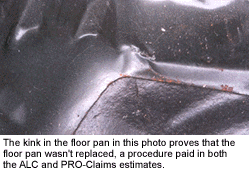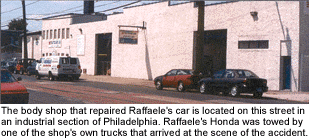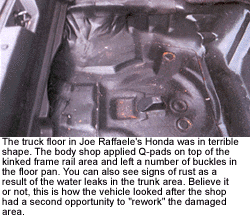Insurance fraud is a hot topic these days. Industry-sponsored ads and billboards tell us that the cost of fraudulent claims is spread over all insured parties and that it affects everybody’s money when people cheat. However, most assume that if a fraudulent act involves an insurance claim, it’s the insurance company that’s victimized. Yet there’s another type of fraud, one that’s far more common and even more devastating to consumers: the all-too-familiar body shop do-si-do.
Specifically, we’re talking about the circumstances in which a body shop collects funds from a customer based on a proposal that lists specific parts and labor operations to repair collision damage. Such a proposal could be the insurance estimate, the body shop’s estimate or the final repair order (invoice) of the repairing shop. This is the controlling document. While customers can have you repair their car any way they want, it’s how the work is represented to the customers when they pay the bill that counts. When there’s a deviation from the specifics set forth within the controlling document and repair work is misrepresented to the customer, you’ve got fraud.
The confusion over which party is the real victim in these fraud cases and how hard it can be to prove fraud is illustrated in the story I’m about to tell you.

In June of this year, I was contacted by a man from Mt. Laurel, N.J., who had his car repaired after an accident in Philadelphia. The central character in this tale is a retired gentleman by the name of Joe Raffaele, whose 1999 Honda Accord was severely damaged in a rear-end collision. It happened at 2 in the afternoon on Feb. 9, 2001, when he and his wife were in the Northeast part of the city doing some shopping. Raffaele says his life hasn’t been the same since.
When the accident occurred, Raffaele’s first instinct was to see if anyone was injured. As it turned out, both he and his wife were fine, but the driver of the offending car was bleeding from the face. Within minutes, a number of tow trucks arrived on the scene (all vying for a piece of the action). Being a member of AAA and believing this was a time to use the benefits of his membership, Raffaele felt most comfortable awarding the tow job to the truck displaying the AAA logo. Unbeknownst to him, the tow truck actually belonged to Autocare USA, Inc., a body shop on Torresdale Avenue in Philly. As you would expect, Autocare USA got the job.
Raffaele knew neither the tow truck driver nor the body shop where his Honda was taken, but after meeting with the owner of the shop, George Hoffman, Raffaele authorized Autocare USA to do the repair work on his vehicle. At the time, he recalls being impressed with the operation and not that concerned with the damage to his car.

“It was just sheet metal,” he says. “The important thing was that my wife and I were OK.”
That was then. Today, Raffaele is consumed with his Honda, the manner in which it was repaired and with finding a solution. And considering the fact that Raffaele is retired and has made the car his sole mission in life, we’re talking about a determined man … almost obsessed.
Raffaele’s Honda was shoddily repaired. No one (including shop owner George Hoffman) will dispute that. But it was a long, arduous journey that led Raffaele to me – and there appears to be a longer road ahead of him before the situation is resolved.
After having the car for 52 days, Autocare USA released it to Raffaele – only to have the Honda returned with a leaking trunk by its irate owner (one with a penchant for documenting facts and sending certified letters).
But there’s a twist in this story, based on the fact that Raffaele’s insurance company hired two different independent appraisal companies to inspect the car and write damage appraisals. First came American Loss Control (ALC), whose appraiser wrote an estimate and two supplements totaling $7,302.89. The labor rate on that sheet was $38 across the board. Then came another independent from Maryland, E. J. Meisner of PRO-Claims, who was also hired by AIG to adjust the loss. Meisner wrote an estimate for $8,410.27, using a rate structure of $40 per hour, with $42 per hour paid on the frame and mechanical procedures. Outside of that, the two appraisals were essentially the same, each calling for the replacement of the rear floor pan, the left frame rail, the bumper assembly, the L quarter panel, the deck lid and related parts. PRO-Claims wrote for an aftermarket bumper reinforcement, cushion and tail lamp.
On March 15, 2001, Raffaele authorized Autocare to go by the PRO-Claims estimate, making it the controlling document in the repair. In fact, Raffaele sent a certified letter to the shop confirming this. Most important of all (and this is crucial), Hoffman’s shop collected checks totaling $8,410.27 on April 27, 2001, when Raffaele picked up his car. That transaction was the defining moment. When Autocare didn’t go over the estimate and final invoice with Raffaele – line for line and item for item – or present him with the shop’s own repair order, the controlling document became the $8,410.27 PRO-Claims estimate.
This isn’t always so clear because in Philadelphia, the custom is this: You got the check? Here’s your keys. In many cases, customers never see any documents.
Had a representative of the shop made it clear at that time that the shop had deviated from the PRO-Claims estimate and took its own route of repair (one different, but nonetheless safe and guaranteed), Autocare would have nothing to worry about. But that didn’t happen.
Like most consumers, Raffaele was none the wiser when he drove his car away, but a major malfeasance was about to unfold in the coming weeks. When PRO-Claims E.J. Meisner saw the car at a New Jersey Honda dealer – in for a supplement on a bent seat back that was overlooked by both the shop and the appraiser – Meisner broke the news. “He told me my car was now a lemon,” says Raffaele.
And that’s putting it kindly. When asked to elaborate on what Meisner actually said about what had been done to his Honda, Raffaele responds, “You don’t want to know.”
But Raffaele didn’t need an expert to see that the trunk was full of water, that the deck lid didn’t close properly, that the A/C condenser was damaged and that the trunk light failed to work.
When I saw the car in June, Meisner’s comments had real meaning. The floor looked like my bedspread on Saturday morning, and the left quarter panel was obviously the original part – loaded up with plastic filler and still wearing the federal anti-theft standard VIN label in its left lock pillar.

New Jersey shop owner Sam Mikhail, who inspected the car prior to me, says: “I remember seeing the wavy body work and scratches from all the body fillers. I also have a scope with which I was able to see inside the quarter panel. I could see the spaghetti hanging from inside the quarter panel. [The shop owner who did this] must have balls the size of watermelons.”
In a letter dated May 12, 2001, Autocare USA owner George Hoffman sent a letter to David Tatrombone of AIG. In it he explained that due to the confusion between the ALC estimate and the PRO-Claims estimate, his company was overpaid by $2,393.78. He enclosed a check made payable to AIG. Hoffman concluded by saying, “We apologize for the delay in discovering this error and any confusion this may have caused.” Autocare also sent a copy of the letter to Raffaele. Hoffman didn’t, however, account for the fact that both the ALC and the PRO-Claims estimates provided payment for a new floor and a new quarter panel.
On Aug. 29, 2001, I visited Hoffman for his side of the story. I arrived at a busy, well-equipped facility, complete with a towing operation with three trucks. Hoffman was very accommodating and expressed regret for the state of Raffaele’s car.
“I hate being in this position as an owner,” he says. “I’ll lose money on a job to satisfy a customer’s concerns, but Joe Raffaele will not return my calls. I wouldn’t be comfortable with the job either.”
When asked to comment on the discrepancies on the billing and what got done with the car, Hoffman says: “We fixed the vehicle based on ALC’s estimate. AIG overpaid the claim. It was AIG’s money. I did what I thought was right.”
When I asked him why the quarter and the floor were in such poor condition, Hoffman insisted the quarter panel was replaced and had the two paint jobs and filler in it due to his shop’s second attempt to repair the car. “We re-worked it,” he says, offering no explanation for the floor pan.
I then asked Hoffman if he believes Joe Raffaele’s car is now safe to operate. “I don’t know,” he replies. “Safe? Yeah. But I’m not happy with the way the car is. We’re only as good as our worst technician. I fired the tech over the job. I admit fault where we screwed up.”
And screwing up, as Hoffman puts it, is not against the law.
Since my June inspection of the Honda, Raffaele has embarked on a campaign to seek justice in this case, which included his contacing claims supervisors at AIG, the Philadelphia District Attorney and fraud task forces in both New Jersey and Pennsylvania. AIG’s in-house lawyer, Anthony Zarella, stated in a letter dated Aug. 10, 2001, to Raffaele, “The shop has since returned the money to us for the parts that were paid for but not replaced. We in turn sent the money back to you because it’s your money.”
Raffaele notes that the money was only sent to him after two months and it took a certified letter to that effect to get it.
It’s interesting to note that Zarella’s letter consistently referred to the incident as one involving “faulty repairs” and never once used the word fraud to describe what happened. This raises a critical point because to prove fraud, it’s necessary to prove the intent was to maliciously misrepresent facts regarding a financial transaction. In fact, after reviewing Raffaele’s complaint, Philadelphia Assistant District Attorney David Wasson refused to prosecute Hoffman on fraud charges. He told Raffaele this was a civil matter.
Repeated calls to Wasson and the DA’s public affairs office for this article weren’t returned.
“You picked the shop,” is often the word track used by insurers faced with body shop malpractice claims. It’s as if to say the victims of this type of crime in some way shared responsibility for their misfortune. However, if that was a valid excuse to avoid payment of a claim, an insurance company might say the same thing when one of their insureds enters a hazardous highway in the rain or leaves their car parked in a bad neighborhood. The point being, no one expects bad things to happen. And it’s clear in cases like Raffaele’s that insured drivers don’t want improper repair work done to their cars. More importantly, in most cases, insured drivers are in no way an accomplice to fraud.
Furthermore, what possible difference could it make in terms of a claim being valid if the loss was a result of an error in judgment? Errors in judgment cause all sorts of covered losses, such as following too closely, driving too fast, failure to see another car or to look both ways before pulling out. Besides, it’s unreasonable to expect a consumer to be a good judge of a business’ ethics based only on the appearance of a body shop. For example, a recent fraud conviction in the Philadelphia area involved a shop that from all outward signs looked like a first-class establishment, flew an I-CAR Gold Class banner and was located in an upscale suburban location. Nevertheless, the husband and wife owners of the shop were both convicted of multiple counts of insurance fraud.
The circumstances of this Carol Carmon-Whitemarsh Collision case were nearly identical to those that befell Joe Raffaele. The woman whose car got the litigious ball rolling was told by her insurance company to file suit against the shop to recover her losses. This tactic, I might add, runs contrary to the unfair claims statute that forbids an insurer to compel litigation in lieu of fair settlements. That’s like telling an insured to take a thief to court for stealing his radio.
In an effort to have this explained to me and to get AIG’s official position on body shop fraud and malpractice, I contacted Gary Willoughby Sr., vice president of claims for AIG. He refused to comment on the record.
Had he consented to an interview, I would have asked him why AIG wouldn’t step in to protect their policyholder in these kinds of claims. Was there an exclusion from coverage for willful, or even accidental, malpractice? Could AIG not recover all their costs in such a claim in subrogation? This posture, taken by all the insurance companies I’ve come in contact with in these kinds of cases, makes their unwillingness to step up to the plate that much more unconscionable. Yet that’s the way it is.
Though life goes on and the malpractice business shows no sign of stemming, Raffaele keeps fighting the fight. He tells me that AIG hired yet another appraiser to gather the facts in this case, who’ll visit Raffaele’s home in New Jersey to assess the car. Whether this guy’s opinion of the job, the intent of the shop or what their policyholder has been left with will make any difference in the disposition of the claim remains unknown. It’s been AIG’s position all along that the fraud and malpractice are a matter strictly between the shop and Raffaele.
“If this guy had a job to go to, he’d put it behind him and get on with his life,” says Hoffman.
Maybe so. But that doesn’t change the facts. Nor does it change Raffaele’s resolve to see this through to the end.
“There’s the emotional side of this thing,” says Raffaele. “I wake up in the morning, I get my briefcase and I wonder what I’m going to do about George Hoffman.” A
Writer Charlie Barone has been working in and around the body shop business for the last 27 years, having owned and managed several collision repair shops. He’s an ASE Master Certified technician, a licensed damage appraiser and has been writing technical, management and opinion pieces since 1993. Barone can be reached via e-mail at ([email protected]).













